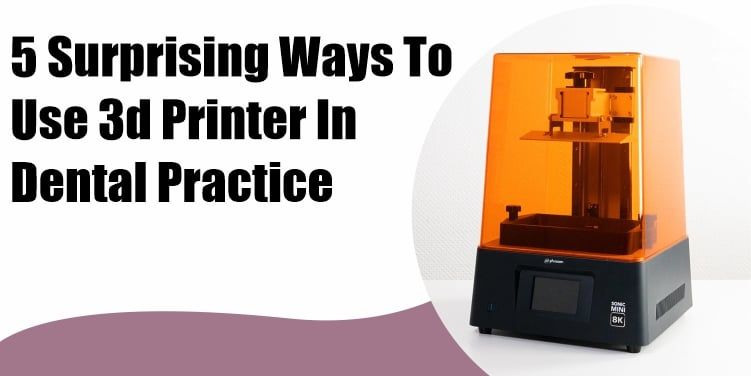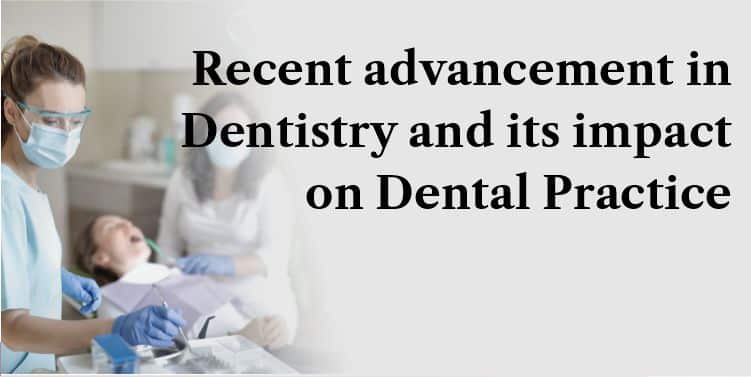3-Dimensional Printing In Dentistry – A Review
Author’s:- Dr. Shaik Ali Hassan1, Dr. Sumit Bhateja
Date:- 3 June’2021
Advanced technology in dentistry has helped a lot in treating diseases properly. 3D Printing allows the dentist to visualize, record hard and soft tissue significantly with precise measurement and print the models. The use of CAD/CAM is the most advanced one in dentistry. But it also lacks the trainee who knows how to use it. In this article, we will show how it is used in various dental treatments.
3D printing is emerging as a good technology in a variety of areas including arts, design, architecture, engineering, medicine, and dentistry. CAD / CAM technology brings 3D printing in medicine and dentistry to revolutionary growth and provides an excellent view of various anomalies.1 3D printing gives medicine based on the anatomic data that radiologists acquire and interpret every day. 3D printing is used mostly to create a natural image of the calcified and noncalcified structures that can be seen as such it is in its normal vicinity position.
Hull invented 3D printing which he named stereolithography. Stereolithography interprets the data in a CAD file by using the file.
In dentistry, using CT and CBCT data, and also using intra-oral or laboratory optical surface scan data. Advancement in computer technology and software applications has contributed a lot to 3D printing. The 3D printing process begins with the design of a virtual image of the object to be created and then converts the information into a digital file. A 3D modeling program provides the virtual design that the printer should follow. This requires CAD software that can be used to create objects from scratch.

3d image of fracture of the mandible
In oral surgery
Using 3d print the perfect anatomical models can be obtained which is used for new treatment and planning purposes as it allows the surgeon to get an overview of the complex structures before performing surgery on a patient.5 When reconstructing jaw and facial defects, in addition to maintaining uniformity and anatomical appearance, it is also important to restore tissue function. Autologous bone grafts remain the standard for the reconstruction of the jaw and facial defects due to their osteoconductive and osteoinductive properties.
The main disadvantage of autologous bone grafting is that it is necessary to manually model the shape of the defect. Therefore, less invasive treatment is needed to treat bone defects. Computer-assisted modeling and rapid production require a series of events that converts a computer-designed virtual three-dimensional image into a solid model for clinical use.6 It is also used to customized reconstruction plates and morphological reconstruction of bony defect areas for cases of fractures.
In orthodontics
Invisalign system digitally realigns the patient’s teeth to create a series of 3D printed models to build aligners. The patient receives a new set of aligners every two weeks and repositions the teeth for a period of time. This technology saves time, the patient’s record can be stored digitally, printed on demand and minimized physical memory requirements. With CAD / CAM technology, two separate bracketing and fork positioning processes merge into one unit. With this method, the need for maximum individuality with a reduced volume is put into practice.

Aligners built from CAD/CAM technology
In restorative dentistry
Since photopolymerization has long been used in dentistry, 3D printing approaches based on UV or visible light. Therefore, resins are commonly used in 3D printing, but have shown some contraction due to their light-activated and mechanical polymerization properties. Therefore, 3D technology is used.9 While fabricating restorations, customary CAD/CAM processing frameworks give various focal points to clinicians and patients, including accuracy. Be that as it may, there are additionally hindrances to subtractive generation strategies. Milling the restoration from a ceramic block, for example, wastes some of the raw material. In addition, exposure to tooling during production presents the possibility of microscopic cracks in the ceramic surface. These shortcomings could be minimized or even eliminated with 3D printing.
In maxilofacial prosthesis
3D printed implants are used to replace and reconstruct the zygomatic bone, the temporal bone, including the auditory ossicles, the calvaria and the jaw. They are also used in the restoration of soft tissues of the head and neck. They are used appropriately after trauma or tumor resection of the ameloblastoma, extensive restoration of bone and soft tissue is required. 3D implants significantly reduced cosmetic defects associated with these surgeries.10 In implantology, 3D printing and CAD/CAM are additionally picking up acknowledgment for making surgical templates.11 As per Fuster-Torres et al, the utilization of a CAD/CAM framework, alongside stereolithographic quick prototyping, produces a careful layout that permits increasingly exact arrangement and direction of implants.
In 2014, Vidal and Vidal portrayed a technique that uses advanced scanners, 3D printing, and CBCT to permit embed arranging in a total computerized convention. The technique includes taking intraoral and extraoral pictures so as to assess the esthetic necessities. The smile line, tooth position, and gingival edges are assessed and checked digitally.
Study models are examined with a 3D scanner, making a virtual computerized wax-up. This enables clinicians to decide the ideal embed position. Next, a tomographic embed control is delivered utilizing CAD programming and 3D printing. The guide is along these lines situated while CBCT pictures are gotten and used in a virtual medical procedure to decide the last embed arrangement and position.11 The actual surgical guide is modeled and printed when the CBCT image of the tomographic guide and digital wax-up are integrated and confirmed as a viable placement plan.
The study showed that the implants were accurately placed, as per the presurgical implant planning conducted through the combined use of CBCT, scanning and 3D printing. The implant sites showed proper healing and were later restored appropriately. This combined use of technological advances was shown to be more precise than conventional methods of manual wax up and fabrication of surgical templates.
 In endodontics
In endodontics
Endodontics also profits by 3D technology in the creation of exact aides for application in surgical as well as nonsurgical endodontic systems. 3D printed carefully help in a guided apicoectomy. Aides in nonsurgical endodontic methods are particularly useful for get to cavity planning in instances of calcified canals.15,16 Utilization of 3D printing empowers production of tooth models with sensible anatomical root channel structures by utilizing CT image in this way giving dental students a chance to manage properly, rather than to use of typhodont teeth.
In periodontology
3D printed guides are all the more ordinarily utilized in periodontology for esthetic gingival reconstruction. Persistent explicit careful guides are used for gingivectomy and smile planning.12 The utilization of 3D printing innovation in Regenerative periodontology is still under research. Studies are being done to assess the utilization of 3D printed biphasic platforms to help in tissue recovery of defects and in healing process.13 This procedure is called as added substance biomanufacturing. A CT scan of the defect helps in creation of a wax mold from which is intended to make a scafofold that will help in guided tissue recovery.


Conclusion
With the advent of 3d printing in dentistry that is the use of CAD/CAM technology has had a huge impact on the treatment of patients. It enables the creation of a geometrical form using a variety of materials from digital data in patients. With the increased use of intra-oral scanning systems, in practice in orthodontics by high-resolution printing resin, printing models for restorative dentistry, and lost wax process pattern. Even though 3D printing is becoming cost-effective in the present but still the cost of running, materials used, and maintenance of the machines are still of great problem. There is also a lack of well-trained personnel also causes a lack of the use of 3D printing Dental machines.
Related Blog:- Simplifying Dentistry with Chairside CAD-CAM – An All-in-One Solution
Get The Exclusive Range of Dental 3D Printers and It’s Accessories Available on our Online Store-www.bestdentaldeals.in





Leave a comment